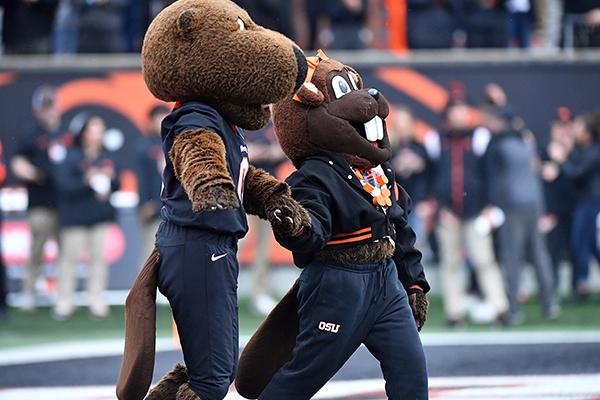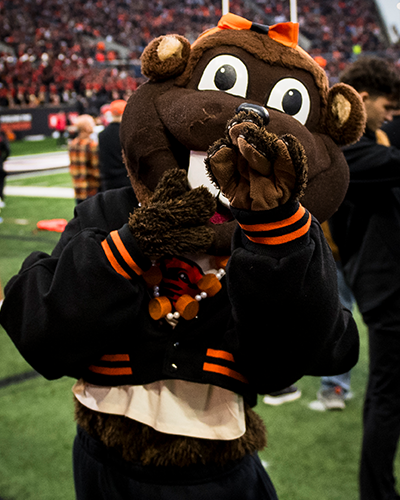Benny was spread pretty thin. It was 1981: eight years since Title IX made gender equity in education a civil right, and at Oregon State, the men’s and women’s athletic departments were about to merge.
The rise in opportunities for women to play sports at the college level — which meant more meets and games — demanded a lot from Oregon State’s bucktooth mascot. A whisper rippled through the departments: “What if there were another mascot?” And then: “What if there were a female mascot?”
Bernice Beaver debuted at Homecoming that year. “It all evolved around getting more and better representation for our women’s programs,” said Sylvia Moore, the director of women’s intercollegiate sports at the time. “We decided to add a second person, and it made sense that that be a woman.”

Bernice and Benny reunite (photo credit: Dave Nishitani)
Bernice was part of an emerging trend of co-mascots; North Carolina State University introduced Mrs. Wuf to represent its women’s teams in 1975, while Frieda permanently joined Freddie Falcon on the field at Bowling Green State University games in 1980. Others soon followed.
This is not to say that Bernice was immediately welcomed as an equal. From her earliest appearances, her relationship to Benny was ambiguous: she was positioned, variously, as an aunt, a sibling, a romantic partner and a “female counterpart.”
Some people inside the Athletics Department felt that introducing a female mascot was frivolous, Moore said — just as some people inside the athletics department also didn’t welcome the merge between men’s and women’s programs. It wasn’t until the late ’80s, she added, that Bernice was accorded a similar amount of recognition to Benny. (Eventually, she was canonized as Benny’s girlfriend; they attended Homecoming as dates, dapper in a tux and frilly white dress.)
In 1996, Andrea Talcott, ’95, became the life skills coordinator in the Athletics Department, a position that included overseeing the mascot program. She auditioned new Bennys and Bernices, coordinated their appearances at games and, occasionally, stepped into the beaver suit herself. She also commissioned new uniforms for Bernice from Nike to match those worn by the women volleyball and basketball players. “I really wanted Bernice to take on a story of her own,” she said.

Bernice (photo credit: Karl Maasdam)
Bernice retired without fanfare between 1997 and 1998. But over the decades, nostalgia began to build. After years of discussion, she finally returned to the field during last fall’s Homecoming game against the University of California, Los Angeles.
In addition to refurbishing the costume, which had been stored in the bowels of Gill Coliseum since 1998, Bernice’s reintroduction also required OSU Athletics to reexamine how a female mascot might represent today’s student athletes, said Sara Elcano, senior associate athletic director. If her role reflected women’s athletics at the university in the ’80s, what could her return say now?
At the game, Bernice popped out of a truck wearing track pants and a varsity jacket, but for some, her changing role is about more than a uniform. “What does that mean, to be a female athlete? It means that you are driven, competitive, enthusiastic,
spirited, hardworking — which doesn’t necessarily need to go along with a role of being a girl,” said former mascot Jill Beasley ’99. “But I think that Bernice should embody all of those things.”

